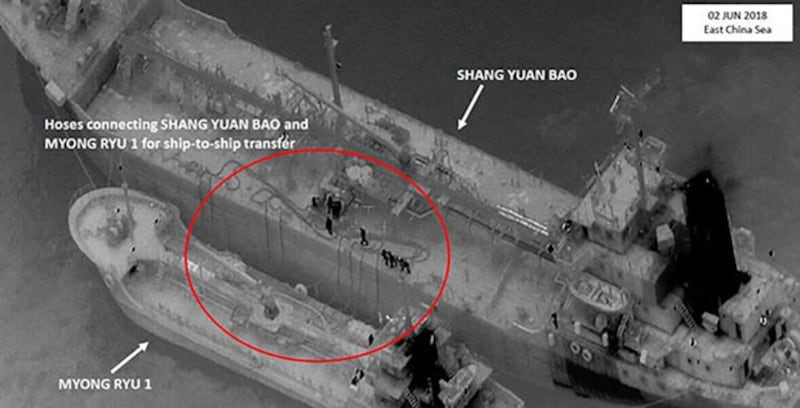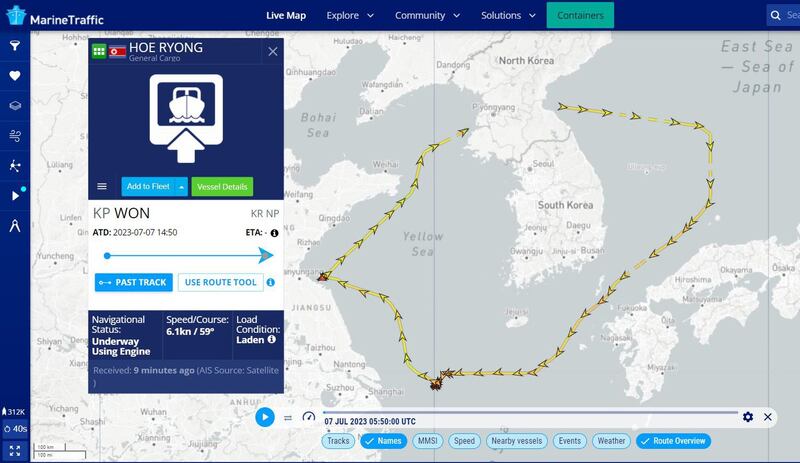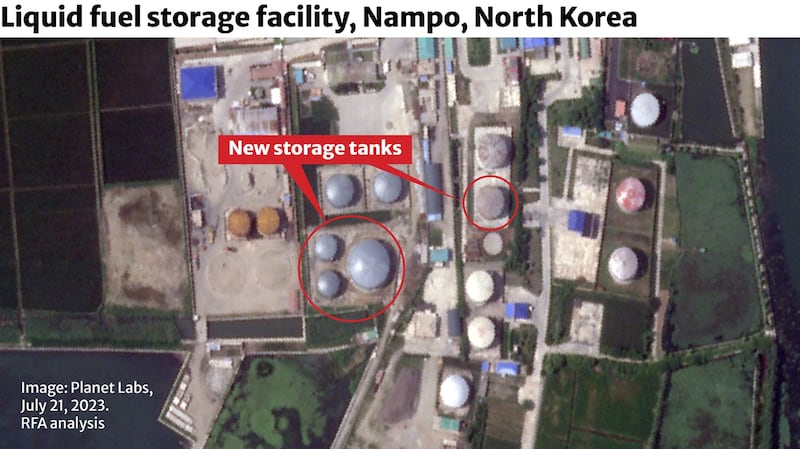More than three dozen ships sanctioned by the United States for facilitating allegedly illicit trade with North Korea have been active this year, including a dozen North Korean-flagged oil tankers, according to satellite images and ship tracking data analyzed by Radio Free Asia.
The information suggests Kim Jong Un’s isolated regime is defying restrictions designed to limit its ability to develop weapons of mass destruction, including through the importation of fuel above quotas set by the United Nations, experts on the region said.
The U.S. Treasury Department has identified a total of 105 vessels – including freighters and tankers – that it says are in violation of sanctions directed at North Korea. Data from Marine Traffic, a global shipping intelligence company, shows 40 have been operating since the start of 2023 in a stretch of water extending from Russia’s Sakhalin Island south to the Gulf of Thailand, the analysis by RFA Korean shows.
Meanwhile, 19 of 59 ships that face U.N. sanctions have been active from the start of the year to August, the analysis shows. Some vessels face both U.S. and U.N. restrictions.
Continued defiance
Though it’s difficult to know exactly what the ships are carrying, Bruce Songhak Chung, a researcher at the Korean Institute for Security and Strategy, said the images suggest that an illicit trade of crude oil and petroleum products continues.
In December 2017, the United Nations Security Council adopted a resolution capping the amount of crude oil and refined products North Korea can import annually at 4 million barrels and 500,000 barrels respectively.

But the regime has long been thought to exceed those totals through smuggling. In 2019, a report to the council said that North Korea "continues to defy Security Council resolutions through a massive increase in illegal ship-to-ship transfers of petroleum products and coal."
According to the data reviewed by RFA, 26 of the 40 sanctioned ships are oil tankers, with 12 owned by North Korean entities. The tally of vessels sanctioned by the United States likely undercounts the amount of shipping to and from North Korea, given efforts by that country and its partners to circumvent tracking mechanisms.
The data shows the continued difficulty of enforcing maritime controls, said James Byrne, the director at the Royal United Services Institute, an U.K.-based organization that traces and analyzes illegal shipping activities.
“Due to the fact that smuggling and transshipment occur in international waters or North Korea's exclusive economic zone, control is extremely challenging,” Byrne said. “Moreover, there are networks of individuals condoning smuggling in China, and corrupt officials promoting smuggling, making it difficult for the international community to effectively regulate it.”
Port calls
The North Korean-flagged ship Ryong Yon, targeted by U.S. sanctions in November 2017 for contributing to the regime’s nuclear missile program, docked at Dalian Port in China, directly west of Pyongyang, on Aug. 22.
In July, the Hoe Ryong, a cargo ship owned by North Korea's Ocean Maritime Management Company and sanctioned by both the U.S. and the U.N., anchored near Chenjiagang Port in China. In 2022, the U.N. panel of experts said the ship unloaded coal in waters off China’s Ningbo-Zhoushan port in violation of international sanctions.

The Chinese Embassy in Washington said it wasn’t aware of the activity and declined to comment.
China once enforced U.N. sanctions, but in recent years, undisguised trade with North Korea has been on the rise, said Andrew Boling, the portfolio manager for state-sponsored threats program at C4ADS, a Washington, D.C.-based global security nonprofit that tracks illicit networks.
"When goods are transferred at sea, this may allow Chinese officials some level of plausible deniability. But North Korean ships also routinely dock at Chinese ports, particularly in the northern part of the country, and likely offload coal and other freight prohibited for export by the United Nations," Boling said.
Individuals or entities designated by the U.S. government for sanctions have all their U.S.- based assets frozen and are prohibited from engaging in transactions involving U.S. individuals.

In addition to the shipping data, satellite images show the western North Korean port Nampo appears to have expanded its liquid fuel storage capacities.
Four new facilities have been constructed at the port southwest of Pyongyang, the images show.
Songhak Chung of the Korean Institute for Security and Strategy said the images, recorded by Planet Labs, a satellite data company, suggest the port now has 22 storage facilities, up from 18.
Translated by Claire Shinyoung Oh Lee for RFA Korean and e dited by Jim Snyder and Abby Seiff.
